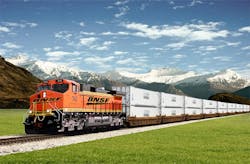Port of Quincy gets aboard rail freight transport group
The Port of Quincy WA is participating in a major effort to improve rail freight movement across the Great Northern Corridor. This area spans the northern tier of the western United States from the Puget Sound and the Lower Columbia River to Chicago through Washington, Oregon, Idaho, Montana, North Dakota, Minnesota, and Wisconsin.
Representatives from these states (including the Port of Quincy) have formed the Great Northern Corridor Coalition to promote regional cooperation, planning, and shared project implementation to improve the movement of rail freight.
The Port of Quincy has a state-of-the-art Intermodal Terminal on the BNSF Railway mainline that goes from Seattle to Chicago, and is only a few minutes away from Interstate 90. This terminal includes 10,000 feet of track, and a container maintenance and cleaning facility in close proximity to provide perishable, frozen, and produce shippers with distribution and storage capacity in and out of Washington.
The Intermodal Terminal is home to the Cold Train, which was launched by Rail Logistics in early 2010 in partnership with the Port of Quincy and BNSF Railway. Since the Cold Train Express Intermodal Service was launched, it has grown in popularity with shippers in the Pacific Northwest and the Midwest and East Coast.
The Port of Quincy is also developing a reputation as a premier location for produce packing and frozen processing, and perishable and frozen foods shipping and distribution, especially given its location in the heart of the major fresh produce growing region in central Washington. According to a recent study of 29 western US and Canadian locations with intermodal connections to regional markets, Quincy WA ranked as the lowest-cost location for operating a distribution center or a warehouse.
Currently, more than 203 million tons of freight moves annually over this corridor, a rail freight transportation network that directly serves 27 million Americans and goes across hundreds of miles of critical agricultural areas. If the Great Northern Corridor did not exist, more than 203 million tons of freight that currently moves by rail would have to travel by long-haul truck every year. It would take about 4.8 million long-haul trucks annually to move that much freight.
The coalition is working to strengthen the corridor in order to promote economic growth for neighboring communities and accommodate demand for safe, efficient, and environmentally sound transportation services.
The first step of the coalition’s process is underway, conducting a Strength, Weaknesses, Opportunities, and Threats (SWOT) analysis to identify opportunities to improve operations and infrastructure along the corridor. This study will be conducted by Olsson Associates, Parsons Brinckerhoff, and The Beckett Group with funding through the Federal Highway Administration Multistate Corridor Operations and Management Program, as well as funding from coalition partners, including the Port of Quincy.
Next in strengthening the corridor will be using results from the SWOT analysis to develop viable strategies and projects that will improve multimodal transportation system management and operations. The analysis is expected to be completed by autumn 2014 with analysis of identified projects and initiatives beginning immediately thereafter.
For more information, contact Patric Connelly of the Port of Quincy at 509-214-7696.

